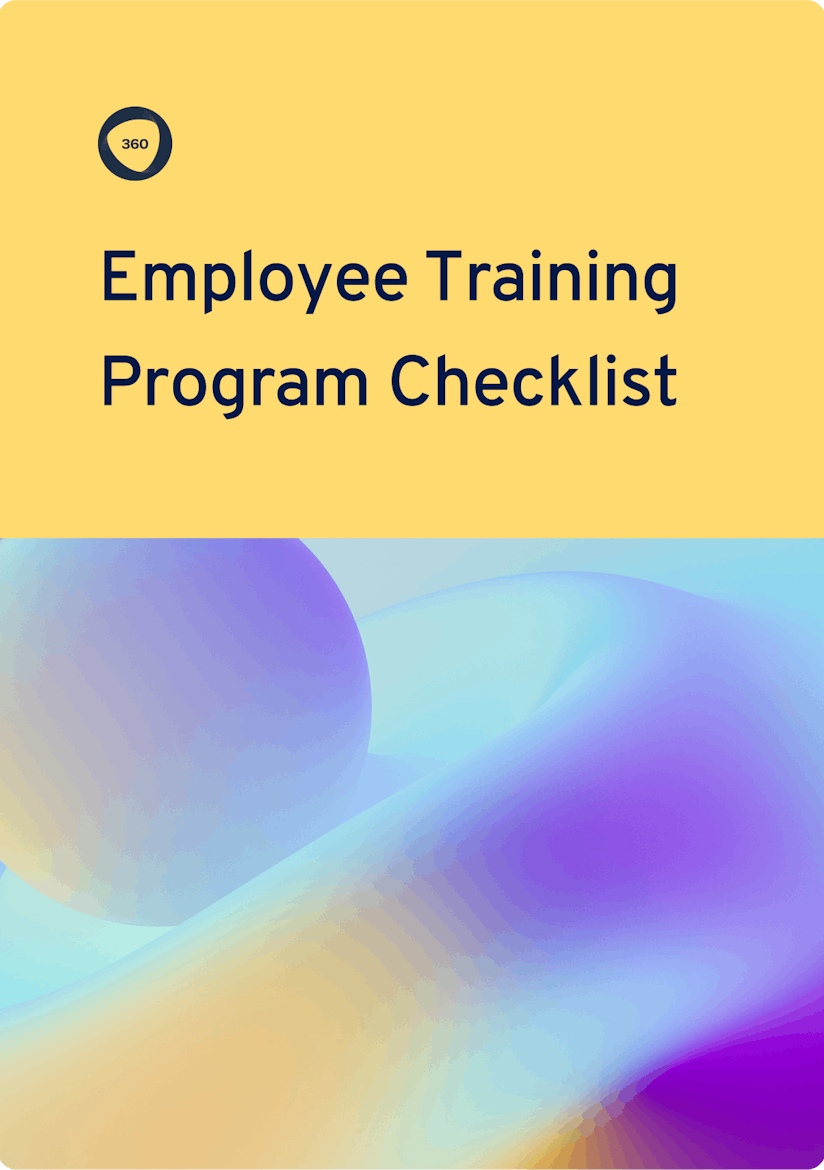
As we’ve written about elsewhere, Learning and Development professionals must match their learning strategy with company business goals. And although the process sounds complicated, it doesn't have to be if you have the right tools.
A great place to start is with the annual training plan for employees. Leveraging these documents will help you and your team meet the training needs of employees, and make meeting those organizational goals much more achievable.
Today, we’ll walk you through the six key components that make up an employee training plan, guide you toward some free templates to get you started, and outline how a learning management system (LMS) can help get you going.
So, what is an annual training plan for employees?

Make sure you cover all your bases.
By providing your contact info, you agree to receive communications from 360Learning. You can opt-out at any time. For details, refer to our Privacy Policy.
What is an annual employee training plan?
An annual employee training plan outlines a training program for your whole organization’s employees. This is the then used to build individual training and development plans per employee, and is crucial for structured training management.
The annual development plan should include your desired training goals, learning outcomes, and training methods. A training plan will consider current employees’ skills in the context of your organization’s short-term business goals.
To achieve long-term success for employees and your organization, considering employee development plans in your annual training plan process is crucial. These plans concentrate on individual career growth and are essential for the maximum impact of your learning strategy and the overall success of your annual training plans.
Before we move on to what you need in your training plan, let’s quickly address a must for any modern and effective training strategy: a training needs analysis.
Start with a training needs analysis
To design an effective training plan, you'll need to identify the intended employee training objectives your plan will achieve. In other words, training resources do your teams need?
This question is best answered by a training needs analysis. This identifies the skills your employees need to do their job well, and highlights the areas where you’re currently under-resourced. It will also help you decide which training materials or programs will impact your employees’ everyday work.
To help get you started, here are some free resources to help you plan a training needs analysis:
- Six steps to a great training needs assessment
- Plus, check out our free training needs analysis template
- Training Needs Assessment Template from Excel Templates
Now, we can delve into the nitty gritty of designing your first annual training plans.
7 key parts of an annual training plan
Creating an annual training plan that delivers results require you to carefully consider seven essential components.
By incorporating these seven elements, you ensure your employees gain new skills and competencies while helping your business reach its goals.
1. Current role or mission
To create an effective training plan, it's crucial to clearly understand the employee's current position or the organization's role and mission. This knowledge will help determine the most beneficial training content based on employees’ responsibilities and functions.
2. Training needs
Your training needs analysis will have given you a head start here, but you will need to define current employees’ skills, existing skills gaps and the new skills they need to carry out their jobs effectively.
3. Training goals
A training plan will need to include achievable training objectives and action plans for employees to reach them. Making these training goals SMART (Specific, Measurable, Achievable, Relevant, and Time-bound) helps you align these goals to benefits for both employees and the company.
4. Type of training
The annual employee training plan will include the types of training activities or courses that will help employees learn their new skills and reach those training goals.
Some different types of training to consider when developing your training programs include:
- In-person training: Job training that occurs face-to-face and can include mentoring, instructor-led training, coaching, or seminars.
- Virtual training: eLearning is a training process that includes online training courses, virtual reality, recorded lectures, or videoconference seminars.
- Blended learning: An L&D approach that traditionally splits learning into in-person training and self-paced eLearning.
5. Resources
A training plan will list the training materials and resources employees can access or leverage to help them reach their goals. These can include resources supplied in training sessions, such as textbooks or company policy.
6. Success metrics
When planning your training program, it's essential to consider how you will measure success. Creating SMART goals is a good start, but it also helps to clearly define success metrics so you and your employees can understand how the training will improve job performance.
7. Training schedule
Finally, you need a roadmap for the training plan. This includes the dates for training sessions, the time necessary to complete the plan, and when check-ins will occur to discuss and adjust the plan. A step-by-step schedule is ideal, or as detailed as you can reasonably achieve.
Why is an annual training plan beneficial?
Training plans help you and your team understand the gaps in employees’ skills and knowledge. They ensure employees have the competencies to perform in their roles, and help the organization reach those crucial business goals.
These plans also empower employees to optimize and enhance their job performance. They set goals to learn new skills or attend refresher training sessions, to help boost their confidence and ramp up productivity.
Plus, a good training plan is sure to improve employee retention. Studies show that companies with strong learning cultures have 30%-50% higher engagement and retention rates.
By implementing training plans, you provide them with growth opportunities, increasing the likelihood that they will stay with the company. A well-designed plan can also help with succession planning and retaining organizational knowledge.
Templates for annual training plans
Now it’s time to build your own. Here are some annual training plan templates to provide you with a foundation and inspire ideas.
We’ve curated two types of free employee training plan templates you can leverage today: New-hire training and individual development plans.
You can also leverage these 23 employee training templates and checklists for better training programs to get your annual training plans up and running.
New hire training plan
We recommend you implement a new employee training plan template for all your new hires.
These new hire training plans can be the same for everyone, covering the organization’s culture, policies, and business goals. They should also include role-specific plans to help employees learn the new skills needed to perform in their role.
Here are some templates and checklists to get your new hire training plans up and running:
- Our Extended New Employee Checklist For Achieving 93% Engagement
- New Employee Training Plan Template
- Onboarding New Hires
- New Hire Onboarding
Individual development plan
These training plans are for current employees and will generally be part of a regular performance review or an employee development plan.
These plans will focus on developing an employee’s existing skills with specific training programs to help them ramp up their job performance. Additionally, you can leverage individual development plans in succession planning, developed in collaboration with the employee.
The following employee development plan examples can help you get started:
Collaborative learning and annual training plans
For absolute best results, combine your new annual training plan with the right delivery tools. That means a well-built learning management system (LMS) that helps employees learn from one another and boost the collective skills of your entire organization.
360Learning helps you build upskilling and reskilling training activities, automates your routine tasks with a few clicks, and empowers your internal experts to collaborate with your team to create impactful training programs at pace.
Talk to us to build the perfect training and development plan for your employees.




